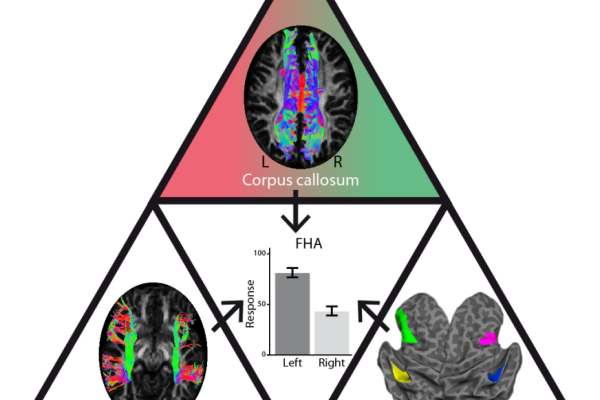2016-01-22

Some might think of the two brain halves as roommates - while they share the same spot within your body and like to do some things together, they still have their own interests and excel in different things. Most prominently, the left hemisphere is a genius in language whereas the right hemisphere is great in mental rotation. Researchers have often tried to find out, what causes these so called functional hemispheric asymmetries. Some argue that the answer lies in the connection between the two brain halves - others say that the difference in gray matter is key. Although both perspectives are reasonable, one factor has often been neglected: the hemispheric differences in white matter connections. In our recent review, we argue that the neurobiological underpinnings of functional hemispheric differences can only be understood, if all known factors will be combined. We hence propose a “triadic” model of functional hemispheric asymmetries, which pillars represent the differences in gray matter, the callosal connection between the two hemispheres and finally the differences in the white matter within each hemisphere. These anatomical predictors are independent from one another and deliver unique contribution in predicting functional hemispheric asymmetries. Thus, we hope to increase our understanding of this interesting phenomenon, by integrating our knowledge of different factors, instead of looking at each one separately.

Some might think of the two brain halves as roommates - while they share the same spot within your body and like to do some things together, they still have their own interests and excel in different things. Most prominently, the left hemisphere is a genius in language whereas the right hemisphere is great in mental rotation. Researchers have often tried to find out, what causes these so called functional hemispheric asymmetries. Some argue that the answer lies in the connection between the two brain halves - others say that the difference in gray matter is key. Although both perspectives are reasonable, one factor has often been neglected: the hemispheric differences in white matter connections. In our recent review, we argue that the neurobiological underpinnings of functional hemispheric differences can only be understood, if all known factors will be combined. We hence propose a “triadic” model of functional hemispheric asymmetries, which pillars represent the differences in gray matter, the callosal connection between the two hemispheres and finally the differences in the white matter within each hemisphere. These anatomical predictors are independent from one another and deliver unique contribution in predicting functional hemispheric asymmetries. Thus, we hope to increase our understanding of this interesting phenomenon, by integrating our knowledge of different factors, instead of looking at each one separately.